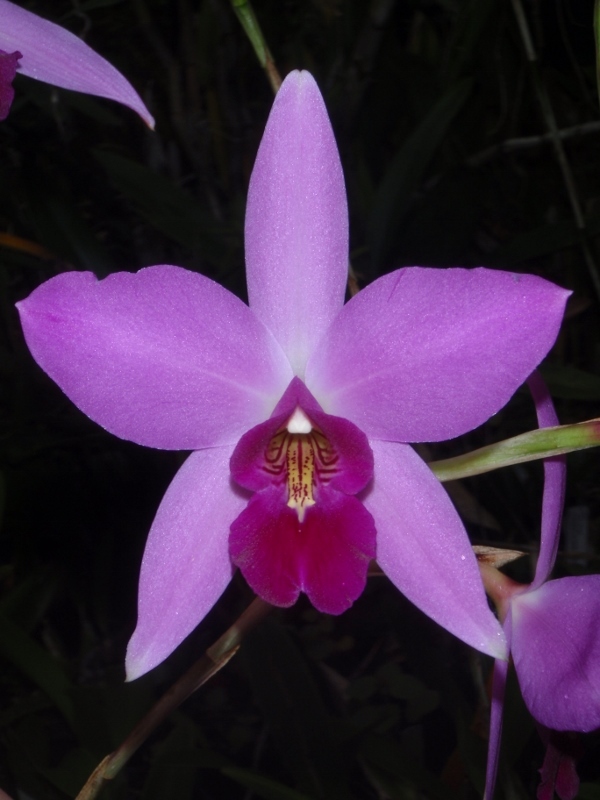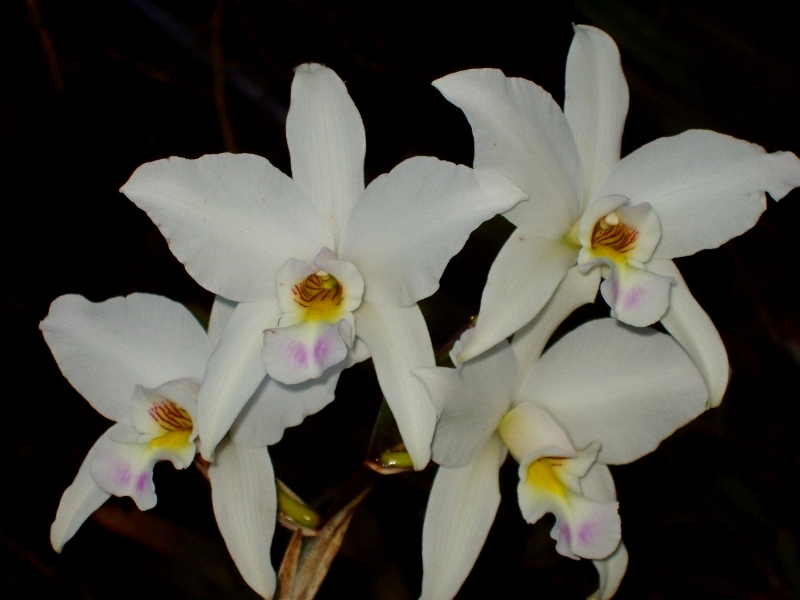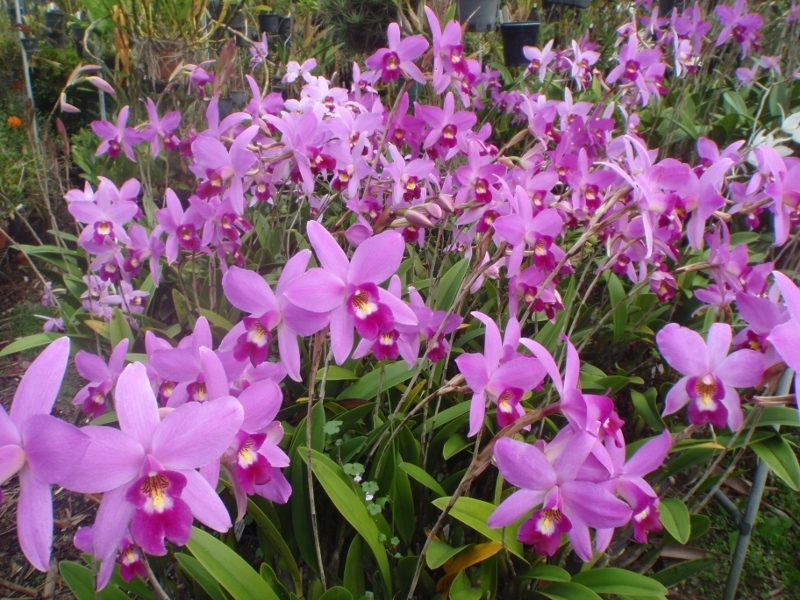Text, plants and photos by David P. Banks (Hills District Orchids, Sydney)
Laelia anceps would be one of the most popular and rewarding orchid species to enter cultivation. It is a vigorous plant that is a reliable bloomer each year and is an ideal beginner’s orchid, as well as an outstanding landscape plant in frost-free climates. By selecting a number of different forms and cultivars of the species, it’s possible to have blooms of Laelia anceps from April through to August, an extended period of five months.
John Lindley first described this highly variable species in 1835 in the Botanical Register. Since that time, many “varieties” have been named in numerous books and journals throughout the world, to the point that over a century ago it seemed that every new colour variant that was found ended up with its own name. Many of these should in fact be simply referred to as cultivars. Today we have plants as cultivars, forms, varieties and subspecies. I won’t go into the details of the taxonomy and classification of wild populations of Laelia anceps, as this was comprehensively covered in the excellent article by Gary Yong Gee, entitled “Laelia anceps – sorting out the confusion” published in the AOR 64 (3): 11-20 [June/July 1999].
Laelia anceps is primarily an epiphytic species of the open forests that occasionally will colonise suitable rockfaces in quite exposed positions. Laelia anceps is almost always found in areas that receive quite strong sunlight. It is distributed in the mountains on the Gulf side of Mexico in the states of Tamaulipas, San Luis Potosi, Hidalgo, Querétaro, Puebla, Veracruz, Oaxaca, Chiapas, and also into Guatemala (where it is uncommon).

Lavender is the most common colour form; however populations of Laelia anceps subsp. dawsonii invariably have white petals and sepals. There are cultivars that appear white but have the faintest of pink flushes, through various stages of pink through lavender to purple. There are also pure white (albino) forms, as well as individuals with splash-petalled, peloric and feathered flowers.
The purpose of this article is to showcase some of the newer cultivars that have bloomed in cultivation, many the result of deliberate line-breeding of the species. Primarily the most outstanding work has been undertaken in the United States by nurseries such as Santa Barbara Orchid Estate, Carter & Holmes and Cal-Orchid. There has also been the bonus of “improved” clones through unexpected desirable mutations which occurred during the meristem process.
Typical examples of Laelia anceps produce quite narrow segmented flowers on inflorescences that generally only have a couple of flowers. Some of the more superior forms today can have up to five large (120mm) blooms on spikes about a metre long.

There are many plants labelled in Australian collections as Laelia anceps ‘Chamberlainiana’. Quite a number of these do not fit the original description of what was originally described as a variety and awarded a First Class Certificate from the Royal Horticultural Society way back in 1902. It was described as “a grand cultivar and the largest of all”. Unfortunately, there are those that put the name ‘Chamberlainiana’ to any plant that has large flowers produced on a long inflorescence. The telltale sign is in the labellum, which is large and most colourful with flared sidelobes. After seeing the famous Laelia anceps ‘Sanbar Gloriosa’ FCC/AOS in bloom at the Santa Barbara Orchid Estate (California), and further discussions with “the orchid man” Paul Gripp, I am convinced they are the same cultivar.
Laelia anceps ‘Irwins’ AM/AOS is another of the famous American cultivars that has been around for more than 40 years, being awarded back in 1976. I have been unable to discover the history of this plant, and do not even know if this is a “wild” cultivar. It’s been in Australia for more than 30 years and I can remember buying a small division of it from Tamborine Mountain Orchids in the mid 1980s. It’s one of the first of the cultivars to bloom in mid- to late autumn and has darker, flatter flowers with broad segments and an outstanding and distinctive somewhat flared deep purple labellum. It’s also a very vigorous plant.
Laelia anceps ‘Mendenhall’ AM/AOS first bloomed in 1988 (awarded in 1991) and was the result of a spontaneous mutation found in a group of normal plants produced by the Carter & Holmes nursery. It has larger flowers, and slightly wider segments than ‘Irwins’ and is certainly a very desirable flower. A number of equally high-quality cultivars then sprang up in the 1990s but their origins are somewhat clouded. I have spoken to a number of “anceps enthusiasts” (plus seen printed tags on some of the original plants) and it appears there is a mix of plants that have been “improved” through the mericloning process, as well as seedlings derived from selfings of both ‘Irwins’ and ‘Mendenhall’. Some of these include the cultivars ‘Bravo’, ‘Cloudland’ HCC/NSW (2000), ‘Déjà Vu’ AM/AOS (1997), ‘La Reina’ HCC/AOS (1993), ‘Tierra del Fuego’ AM/AOS (1996) and ‘Ultimo’. The majority of these clones appear to have originated in the Santa Barbara region of California, many via James Rose of Cal Orchid. This style of the species has become one of the most popular with many enthusiasts, nurserymen and collectors devoting a lot of space for their expanding collections of this orchid. A shadehouse full of Laelia anceps in bloom is an impressive sight.
These improved cultivars of Laelia anceps led to a further increase in their popularity and a renewed interest in line-breeding the species further. Many sibling crosses were made using the sister clones ‘Irwins’ and ‘Mendenhall’ with other unrelated cultivars, as well as some of the already advanced progeny.

Being a big fan of Laelia anceps, I have always been on the lookout for different clones of the species, plus seedlings when they are available. When purchasing seedlings (and this goes for all types of orchids) if you really want a better chance of getting something a bit special, you need to buy multiples of a cross, not just the one seedling. Look at it like a lottery, the more tickets you have, the more chances of winning. Similarly, buying just one seedling of a cross (but buying one each of a number of crosses) is like buying one ticket in a number of different lotteries. I flowered quite a number of seedlings of the sibling cross between ‘Irwins’ and ‘Ultimo’, and most were very nice, but one of these was simply outstanding. Laelia anceps ‘Lynette’ FCC/AOC (2021) is the finest of the deep-lavender types that I have seen. It produces up to three very large and flat blooms with a solid deep-purple labellum. Photographs I have shown of this plant, named after my mother, have impressed growers and breeders here and overseas. It was awarded a First Class Certificate in June 2021, through the Orchid Club of South Australia and the Australian Orchid Council.


Another successful crossing was a combination between ‘Irwins’ (which now also has a fine reputation as a pod parent) crossed with a superior form of the white-flowered Laelia anceps subsp. dawsonii. This produced a race of plants that are quite different to those that occur naturally in the wild. They are also early flowering (starting mid-autumn) and have flat pale- to mid-lavender blooms highlighted by a labellum that has a distinctive white disc in the centre. A feature I find most attractive. Laelia anceps ‘Louanne’ is the pick of these, followed by the very similar clone Laelia anceps ‘Rebekah’. Another seedling showing a lot of potential is the very pretty Laelia anceps ‘Lollypop’. There is obviously a lot of potential in using the different populations of plants to utilise the expanded gene pool.
For those who like novelty types, there are striped forms of Laelia anceps. The plants with striped petals have been called lineata, striata or disciplinata type. The most accepted term for these has been as forma lineata, which I follow here. I have been told that Laelia anceps forma lineata ‘Doris‘ is a wild plant, and one of the first of this type to enter cultivation. When selfed a small percentage of the progeny (about 25%) maintain the stripes in the petals, while the others revert to more “normal” types. Laelia anceps forma lineata ‘Tinonee Splash’ is a result of the selfing of ‘Doris’ and on a larger plant may prove to be superior.

However, the really choice striped types have come from the crossing of ‘Doris’ with ‘Ultimo’. I bloomed well over a dozen seedlings of this cross, and most were fine forms of the ‘Irwins’ type, however I have been lucky to bloom three excellent and similar plants with a combination of outstanding form, colour and the feathered striping and splashing on the petals. I believe that Laelia anceps forma lineata ‘Neon Splash’ is the pick of them with Laelia anceps forma lineata ‘Autumn Splash’ and Laelia anceps forma lineata ‘Parramatta Splash’ right on its tail. This style is very new in Australia and while maybe not one for the purists it certainly has a lot of horticultural appeal. These are fast-growing plants with increased vigour over the original ‘Doris’.

Laelia anceps var. barkeriana ‘Royal Flush’ is one of the darkest-coloured forms of the species I have seen. It has been used a bit in breeding and has produced some fine progeny when mated with the “Guerrero” types (forma chilapensis).
Laelia anceps ‘Compacta’ is a plant that was imported by my father Graeme Banks OAM from Mexico in 1981. The pseudobulbs are crowded and rarely taller than 50mm with the upright inflorescences seldom over 30cm long with one or two mauve-pink flowers. Its lip has a yellow disc with red-purple veining and a darker purple mid-lobe. This cultivar has a compact growth habit with fairly typical flowers but shows potential as a pot plant or line breeding to reduce the invariably long inflorescences of the better cultivars.

The “Guerrero” types (correctly Laelia anceps forma chilapensis) are still fairly scarce in Australian collections. This type is generally characterised by having wide petals that attractively fade from white to lavender. Laelia anceps forma chilapensis ‘Mini Guerrero’ is a plant from the fine private collection of Norm Wieder of Santa Barbara. However, arguably the best clone in cultivation is the outstanding Laelia anceps forma chilapensis ‘Sanbar Guerrero’ AM/AOS (1985). This is a plant that Paul Gripp personally selected when in Mexico many years ago. It has pale-pink sepals and broad pale-pink petals that grade to a glowing rose-lavender towards the tips. The lip has a yellow throat with red-purple veining, the side-lobes are rose-lavender and the striking mid-lobe is solid velvet-red to black-purple. Interestingly, when awarded the AM the plant carried only two flowers, yet expert Santa Barbara grower Don Brown (who also has an outstanding and diverse Laelia anceps collection) last year bloomed it with five large flowers on one very long inflorescence. This clone has been used in a number of sibling crosses.
There is enormous potential for further line-breeding of Laelia anceps and some of the choice newer cultivars should be mericloned in the hope of more spontaneous and improved mutations. If the blooms are kept dry, they will last for about 6 weeks in pristine condition. In areas that experience wet winters, it is advisable to place the plants under cover to avoid spotting of the flowers and a reduced shelf life. If breeding using Laelia anceps as the pod parent, use fresh flowers (less than a week old). The apparent viability appears to drop off quite suddenly after this time. Pollen may be stored in the refrigerator for up to (at least) 3 years. I have no experience with frozen pollen but have heard of others’ success with the pollen of complex Cattleya hybrids.
Cultivation
Laelia anceps is really an easily grown species that is ideal for the beginner, as well as the seasoned enthusiast. Our plants have experienced temperature ranges from -2ºC in winter to 47ºC in summer. Thankfully (for us and the plants) these extremes are for only a short period, but it does show how tough these plants are. The more “normal” range would be 5ºC to 35ºC. During the extreme times, ensure the plants are dry in winter, and during summer heatwaves try to keep the humidity level high around the plants to avoid severe desiccation.
We grow most of our plants in 150mm and 200mm squat pots. These sturdy and well-drained pots (designed essentially for Dendrobium speciosum) are ideal for this fast-growing species. We use a bark-based mix (combination of “medium” and “large” grades, washed beforehand) with about 80% bark with the addition of 10% jumbo perlite and 10% river gravel. It is vital that the medium retains some moisture between waterings, yet is free draining. Plants are grown on mesh benches under 50% shadecloth.

I prefer to divide my larger plants of this species in late winter, after flowering, so to avoid damaging the brittle new roots that are invariably damaged if left till the weather warms up. Don’t be in a rush to divide your plants though, as they look far more impressive when grown as specimens. Don’t discard the older parts of the plant, as pairs of backbulbs readily strike in a fine bark mix or sphagnum moss.
If you prefer, plants may also be mounted on large sections of black treefern or virgin cork. Alternatively they may tied on to suitable trees (those that do not exude gum or shed their bark) in the garden.
The plants enjoy a lot of water throughout their growing period, from late September to March, which replicates what they receive in the wild. They do not require much water in winter, as the plants are in a period of dormancy after flowering, just enough to keep the pseudobulbs from shrivelling. Fertilise as you would for other orchids in your collection.
In Gary Yong Gee’s 1999 article he quoted the weather pattern and temperature range as follows: “In their natural habitat, plants are subject to a rainy season from late spring till early autumn where they are drenched by heavy rains often for up to 5 hours during the late afternoon and evenings. By the next morning fresh winds from the mountains soon dry the plants, which grow vigorously in the full sun until the following daily storm. At the end of winter new roots form from the base of the pseudobulb, which is the time of the short rainy season – a fine fog-like rain that is usually not sufficient to saturate the plants. Temperatures can rise to 28°C or more during the summer and drop to 5°C and even below freezing in winter.”
Acknowledgements
Thank you to the following for discussions on and/or plants of Laelia anceps that assisted to my understanding of this species: the late Sid Batchelor, Don Brown, Ray Clement, Paul Gripp, the late Sandy Holmes, James Rose and Norm Wieder. I am also appreciative of Gary Yong Gee for further stimulating the interest in this species (and species orchids in general) by sharing his vast knowledge through his educational and informative articles. Special thanks to Parry Gripp (co-owner of the Santa Barbara Orchid Estate) for providing me with his thorough compilation (and colour photographs) of American Orchid Society (AOS) awards granted to clones of Laelia anceps.
A bit on trivia for 80s music buffs. The lead singer (Morton Harket) of Norway’s most successful pop group, A-ha (who had a worldwide hit in 1984 with Take On Me) is an orchid enthusiast, whose group before A-ha was called Laelia anceps!
